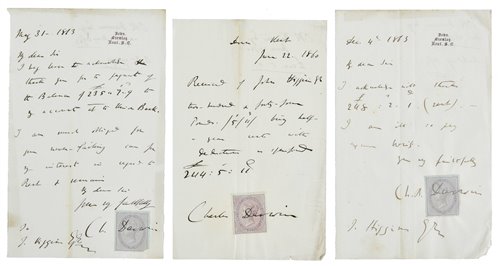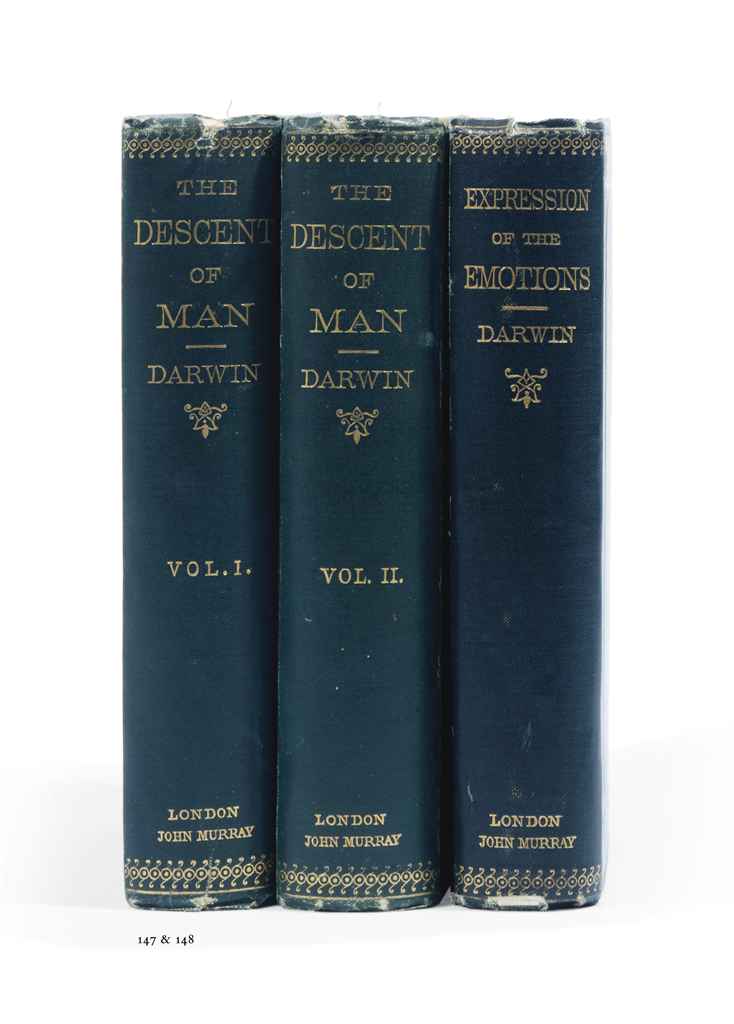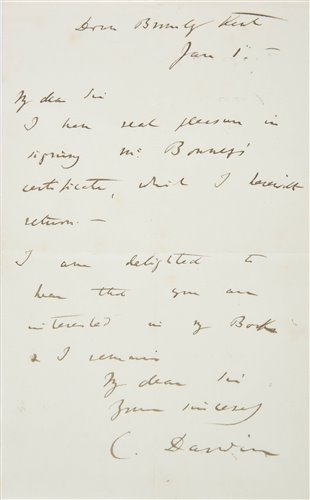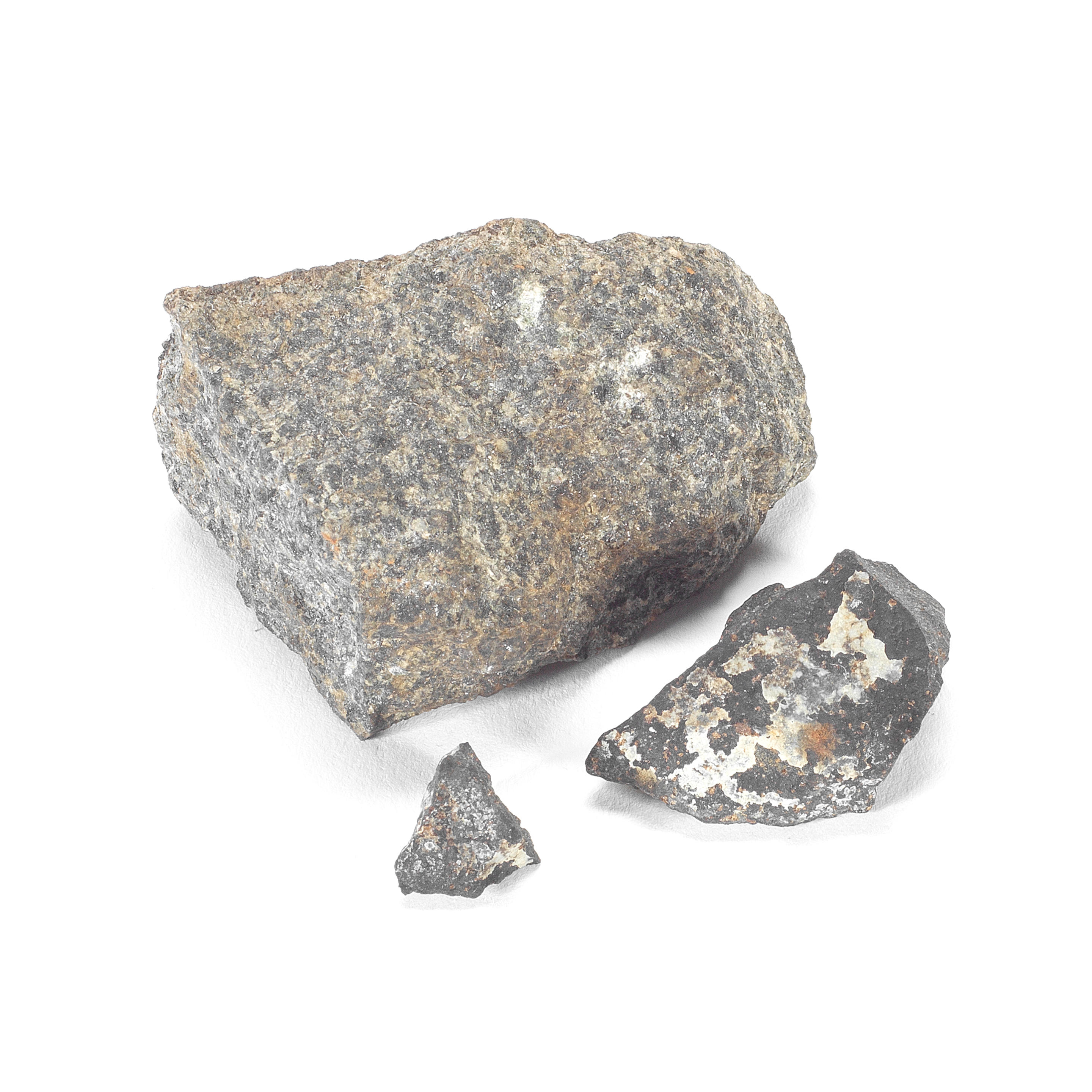Darwin (Charles Robert, 1809-1882). English naturalist, geologist and originator of the theory of evolution. Autograph Letter Signed, ‘C. Darwin’, Down, [Bromley, Kent, after 14 April 1863], to [Daniel] Oliver, concerning ovules in primula [primroses], in full, ‘Many thanks about the Primula: I see that I was pretty right about the ovules. I have been thinking that the apparent opening at the chalaza end must have been withering or perhaps gnawing by some very minute insects, as the ovarium is open at the upper end. If I have time I will have another look at pollen-tubes, as from what you say they ought to find their way to the micropyle. But ovules to me are far more troublesome to dissect than animal tissue; they are so soft, and muddy the water’, alphanumeric '16a' written to upper left corner in Darwin's hand, small pencil number '26a' and 'Apr. 1863' inscribed to upper margin in other hands, album hinge remains to left margin, a few small spots to extremities and a little light creasing, 2 pages, 8vo (Quantity: 1) Darwin Correspondence Project, “Letter no. 4095”. Also published in The Correspondence of Charles Darwin, vol. 11. The date is inferred from two other related letters in the Darwin Correspondence Project, the first from Darwin to Oliver, 12 April 1863, in which Darwin asked about the position of the ovule in Primula; the second from Oliver to Darwin, 14 April 1863, to which the letter offered here is the reply. Daniel Oliver, FRS (1830-1916) was an English botanist. He was Librarian of the Herbarium, Royal Botanic Gardens, Kew from 1860-1890 and Keeper there from 1864-1890, and Professor of Botany at University College, London from 1861 to 1888. Darwin was fascinated by the structure of primula flowers. In his autobiography, he wrote, ‘no little discovery of mine ever gave me so much pleasure as the making out the meaning of heterostyled flowers’ (‘Recollections’, p. 419). There are two forms of primrose flowers, which look almost identical apart from the position of the stigma (female part) and the anthers (male part holding the pollen) in the flower tube in the centre. These are ‘pin-eyed’ primroses and ‘thrum-eyed primroses. In the pin-eyed the style and stigma are taller than the surrounding stamens. In thrum-eyed flowers the stamens are taller than the style and stigma. The two flower types were first described by Charles Darwin in 1862 who also observed that the pollen produced by the pin flowers was smaller than that of the thrum flowers. He performed a number of crosses (taking pollen from one flower and placing it on the stigma of another) and proved that pollination between the two flower types, where the pollen of the different form flowers resulted in greater seed production than pollination between the same forms. Both flower types contain nectar at the bottom of the flower tube to attract insects to mediate pollination of the flowers. Darwin thought that the reciprocal positions of the anthers and the stigma in the two flower types would promote cross fertilisation. He suggested that when an insect visits a pin flower it inserts its proboscis into the flower tube to feed on the nectar, and pollen from the anthers would stick onto the proboscis about halfway down. If the insect then visits a thrum flower the pollen already on its proboscis is at the right level to meet and stick to the stigma about halfway down the flower tube, leading to cross fertilisation. At the same time pollen from the anthers at the top of the thrum flower tube is likely to stick to the top of the insect proboscis, the perfect position for cross-fertilising the next pin flower the insect visits. Primrose flowers also have a ‘self-incompatibility’ mechanism that stops the eggs being fertilised by pollen that is genetically identical. Therefore, the vast majority of successful pollinations in a wild population of primroses are between pin and thrum plants. Charles Darwin, 'On the two forms, or dimorphic condition, in the specie
Darwin (Charles Robert, 1809-1882). English naturalist, geologist and originator of the theory of evolution. Autograph Letter Signed, ‘C. Darwin’, Down, [Bromley, Kent, after 14 April 1863], to [Daniel] Oliver, concerning ovules in primula [primroses], in full, ‘Many thanks about the Primula: I see that I was pretty right about the ovules. I have been thinking that the apparent opening at the chalaza end must have been withering or perhaps gnawing by some very minute insects, as the ovarium is open at the upper end. If I have time I will have another look at pollen-tubes, as from what you say they ought to find their way to the micropyle. But ovules to me are far more troublesome to dissect than animal tissue; they are so soft, and muddy the water’, alphanumeric '16a' written to upper left corner in Darwin's hand, small pencil number '26a' and 'Apr. 1863' inscribed to upper margin in other hands, album hinge remains to left margin, a few small spots to extremities and a little light creasing, 2 pages, 8vo (Quantity: 1) Darwin Correspondence Project, “Letter no. 4095”. Also published in The Correspondence of Charles Darwin, vol. 11. The date is inferred from two other related letters in the Darwin Correspondence Project, the first from Darwin to Oliver, 12 April 1863, in which Darwin asked about the position of the ovule in Primula; the second from Oliver to Darwin, 14 April 1863, to which the letter offered here is the reply. Daniel Oliver, FRS (1830-1916) was an English botanist. He was Librarian of the Herbarium, Royal Botanic Gardens, Kew from 1860-1890 and Keeper there from 1864-1890, and Professor of Botany at University College, London from 1861 to 1888. Darwin was fascinated by the structure of primula flowers. In his autobiography, he wrote, ‘no little discovery of mine ever gave me so much pleasure as the making out the meaning of heterostyled flowers’ (‘Recollections’, p. 419). There are two forms of primrose flowers, which look almost identical apart from the position of the stigma (female part) and the anthers (male part holding the pollen) in the flower tube in the centre. These are ‘pin-eyed’ primroses and ‘thrum-eyed primroses. In the pin-eyed the style and stigma are taller than the surrounding stamens. In thrum-eyed flowers the stamens are taller than the style and stigma. The two flower types were first described by Charles Darwin in 1862 who also observed that the pollen produced by the pin flowers was smaller than that of the thrum flowers. He performed a number of crosses (taking pollen from one flower and placing it on the stigma of another) and proved that pollination between the two flower types, where the pollen of the different form flowers resulted in greater seed production than pollination between the same forms. Both flower types contain nectar at the bottom of the flower tube to attract insects to mediate pollination of the flowers. Darwin thought that the reciprocal positions of the anthers and the stigma in the two flower types would promote cross fertilisation. He suggested that when an insect visits a pin flower it inserts its proboscis into the flower tube to feed on the nectar, and pollen from the anthers would stick onto the proboscis about halfway down. If the insect then visits a thrum flower the pollen already on its proboscis is at the right level to meet and stick to the stigma about halfway down the flower tube, leading to cross fertilisation. At the same time pollen from the anthers at the top of the thrum flower tube is likely to stick to the top of the insect proboscis, the perfect position for cross-fertilising the next pin flower the insect visits. Primrose flowers also have a ‘self-incompatibility’ mechanism that stops the eggs being fertilised by pollen that is genetically identical. Therefore, the vast majority of successful pollinations in a wild population of primroses are between pin and thrum plants. Charles Darwin, 'On the two forms, or dimorphic condition, in the specie

.jpg)

.jpg)
.jpg)
.jpg)


.jpg)
.jpg)





Try LotSearch and its premium features for 7 days - without any costs!
Be notified automatically about new items in upcoming auctions.
Create an alert